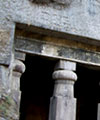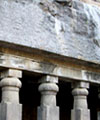| Encyclopedia of Tours and Travel to Maharashtra, featuring information on Fairs & Festivals, Wildlife, Excursion, Adventure and Weather of Maharashtra. |
 |
 |
 |
 |
 |
 |
 |
||
|
Excursion
Forts [ Bassein | Daulatabad | Gavilgad | Ghodbunder | Murud - Janjira | Murud - Harnai | Panhala | Raigad | Sinhagad | Vijaydurg - Sindhudurg ] Bassein About 10 kms to the northwest lies Nalasopara village, the capital of the Konkan region from 1500 BC to AD 1300. Many Buddhist residues were discovered here. Nalasopara is believed to have been the birthplace of the Buddha in a previous life. To the north, is the Agar of Agashi and to the south is the Agar of Bassein. An hour by bus from Bassein station is the Vajreshwari Temple and Akoli Hot Springs. Also easily accessible is Ganeshpuri with the Sadguru Nityanand Maharaj Samadhi Mandir, the Bhimeshwar Temple and other ashrams. From Mumbai, Bassein Fort can be reached easily by local train up to Bassein or Vasai Road station on the Western Railway and then by auto-rickshaw or taxi. It is 77 kms along the Mumbai-Ahmedabad highway. Daulatabad Daulatabad displays many of the internal devices that made it unconquerable. Unusual underground passages lie among the fort along with series of secret. Its defence systems constituted strengthening of double and even triple rows of massive walls. It is a fort conquered only by betrayal. The most remarkable structures at Daulatabad are the Chand Minar, Jami Masjid and royal palaces. The tapering 30-metre high tower of the Chand Minar is divided into four storeys, and was faced with glassy tiles and carved points. The Minar probably served as a prayer hall or a victory monument in its time. The Jami Masjid was a mosque built by the Khilji ruler of Delhi, Qutubuddin Mubarak. The palaces consist of spacious halls, pavilions and courtyards. The fort is open till 6-p.m. Aurangabad is generally from where you would arrive or depart. Aurangabad airport is conveniently located, around 10 kms east of the town, and is directly air-linked to Mumbai, Delhi, Jaipur and Udaipur. There are two trains that depart daily from Mumbai. The Tapovan Express leaves Mumbai early morning arriving in Aurangabad by late afternoon, while the Devgiri Express is an overnight train. Daulatabad Fort is a part of the MTDC tour to Ellora from Aurangabad, but it can be accessed by private taxi or by the local bus that runs between Aurangabad and Ellora. Accommadation: There are several luxury and budget hotels in and around Aurangabad city. The MTDC has a tourist lodge, near the Aurangabad railway station. There is also a youth hostel in the city. Gavilgad Built by the Gavlis, or cowherds in the 12th/13th centuries, the fort was occupied later by the mighty Gonds, the last of the sub-continental powers to fall to the Mughals. Today although no signs of dramatic battle remain, the fort walls and barrier still stand. Four gates guard the strategic entrances with only a cool wind whistling past them. There is no trace of the tunnel, reputedly linking it to the nearby Gond fort at Narnala. You could trek to Narnala, or drive through the thick forest to discover yet another blend of Gond and Mughal influence. Weather: Chikhaldara has an annual rainfall of 154 cms. Temperatures vary from 39 C in summer to 5 C in winter. (October to June is the best time to visit) Getting there: The nearest railhead is Badnera on the Central Railway branch line, 110 kms. Chikhaldara, 763 kms from Mumbai, is connected to most major cities by road. Regular ST buses connect Chikhaldara to Amravati, Nagpur, Wardha, Akola and other cities. Accommadation: The MTDC has a resort in a Chikhaldara, which includes a convention centre. Ghodbunder Getting there: Nearest airport is Mumbai 23 kms. Nearest railhead is Borivali, on Western Railway suburban/main line 8 kms. Mumbai- Ghodbunder, 43 kms. State Transport, Best buses ply from Thane and Borivali to Ghodbunder. Accommadation: Self-contained rooms (5 blocks). Check out time: 8.00 a.m. Reservation: Ghodbunder and Mumbai. Murud-Janjira Never conquered by an enemy for over 350 years since its construction by the Ahmednagar rulers under the supervision of their regent Malik Ambar in the 15th century, Murud-Janjira is probably the only unbeatable fort on the 720-km Maharashtra coastline. Neither the Portuguese nor the British could conquer the fort. And the Marathas, despite their repeated attempts failed to conquer the Siddi power. The palace of the Nawab and the Janjira Caves are also a must for the tourist. And just a few kilometers away are two undiscovered beaches: Nandgaon and Kashid. Nandgaon is famous for its Ganapati temple and the annual fair held in honour of ths elephant-headed God every February. Getting there: Nearest airport is Mumbai, 65 kms., Nearest railhead is Roha 50 kms., Mumbai-Murud-via Revdanda, 165 kms. Pune-Murud via Mahad, 230 kms. Alibag-Murud, 52 kms., State transport buses ply from Mumbai, Pune to Murud. Accommadation: 2/4/6 bedded self-contained 14 rooms. Checkout time: 10.00 a.m. Reservation: Mumbai and Murud. Murud-Harnai Getting there: Nearest airport is Mumbai. Nearest railhead is Khed, 45 kms on Konkan Rly. Mumbai-Murud-Harnai, 247 kms via Panvel-Pen-Lonere Phata-Dapoli. State Transport uses ply from Mumbai, Pune, Mahad to Murud-Harnai. Accommadation: 2/6/8 bedded huts available (Seasonal). Check out time: 12.00 noon. Reservation: Mumbai & Harnai.
Panhala The largest of all Deccan forts, Panhala, was built between AD 1178-1209. Though it was the seat of the Shilahara dynasty since AD 1190, and held successively by the Yadava and Bahamani kingdoms, it is today aromatic with memories of Shivaji. Not surprising, though considering that this is one of the few forts in which Shivaji spent more than 500 days. Visit the innermost castle, or march past the three magnificent double-walled gates, which guard the entry to the fort. You will be awestruck by the huge container, Amberkhana, said to contain 25,000 khandis (50,000 mounds) of corn poured into it from symmetrical gaps in the ceiling. In addition to history, Panhala 20 kms from the industrial city of Kolhapur and at an altitude of 977 m offers some inspiring scenery and a soothing climate, providing the ideal getaway as a hill station. Weather: An average temperature of 25 C. Getting there: Nearest airport is belgaum, 123kms., Nearest railhead is Kolhapur, 18 kms on south central Railway., Mumbai-Panhala, 428 kms via Kolhapur, Kolhapur-panhala, 18 kms., State Transport buses ply from Kolhapur, Belgaum to Panhala. Accommodation: MTDC-self-contained 9 rooms and 4 Tents (seasonal). Privatised self-contained 12 rooms and 2 Dormitories. Checkout time: MTDC 9.00 a.m. Privatised 12.00 noon. Reservation: Mumbai,Kolhapur and Panhala. Raigad You can also visit Gangasagar Lake or worship at the nearby Jagadishwar Temple or pay your respects to the great Maratha warrior at his Samadhi. Getting there:Nearest airport is Pune, 126 kms. Nearest railhead is Veer on Konkan Railway. (40 kms) Mumbai-Raigad, 210 kms. via Mahad. Pune-Raigad, 126 kms. Mahad-Raigad, 27 kms.State Transport buses ply from Mumbai, Mahad and Pune to Raigad. Rope-way is available from foot-hills to the top of the fort (seasonal). On foot, about 1450 steps from foot-hill to the top of the Fort. Accommadation: Self-contained rooms (6 blocks) and Dormitories (2 blocks without beds - 100 tourists). Closed during monsoon. Check-out time: 9.00 a.m. Reservation: Mumbai/Raigad Sinhagad It was here that Shivaji's general, Tanaji Malusare launched an attack to recapture the fort. In the ensuing battle, Tanaji valiantly laid down his life, but captured the fort. A grieving Shivaji is known to have said,"Gad ala pan sinh gela" (The fort is won but the lion has gone). And this is how the fort got its name: sinh (lion's) gad (fort). Lokmanya Tilak, the freedom fighter had a bungalow atop here and Gandhiji is said to have asked for water from Sinhagad, whenever he was imprisoned at Pune, a few kilometres away. You can visit the memorial to Tanaji, or the tomb of Rajaram -- Shivaji's son -- who died here. And if you are fortunate, you may find a priceless jewel or an ancient coin as Sinhgad used to serve as a storehouse of wealth for Pune merchants. Getting there: The fort can be scaled from its many approaches. You can trek from Donaje upto the top. Donaje can be reached conveniently by bus from Pune, 25 kms away. Another shorter and less steep climb is from Kalyan village past the Kalyan Darwaza. Vijaydurg - Sindhudurg Constructed by Shivaji in 1664, at a site personally selected by him. The construction of a sea fort is a stupendous task, and at Sindhudurg no efforts were spared. Over 2000 khandis (4000 mounds) of iron were used for casting and the foundation stones were laid down firmly in lead. Even today, as one approaches the fort past a rocky reef, navigable through a narrow channel, one marvels at the transportation of such heavy material through such choppy waters. Within its precincts are temples holding the shrines of Maruti, Bhavani, Mahadeo, Jarimai, Mahapurush and also of Shivaji -- the only such shrine in the country. As for Vijaydurg and Sindhudurg beaches, they offer the visitor one of the most serene and beautiful coastal views in India. Getting there: Rajapur and Kudal respectively are the nearest railheads on the Konkan Railway.
Sindhudurg by road is 510 kms and Vijaydurg is 425 kms from Mumbai via the Goa highway.
|
||||||||||
|
||||||||||
|
||||||||||
|---|---|---|---|---|---|---|---|---|---|---|
 Bassein Fort, now in ruins, was under the Portuguese a flourishing protected city from 1534 to 1739 when the Marathas sacked it. The ruins of the Portuguese Fort still stand almost hidden by brushwood and palm groves. Some of the walls and churches can still be seen.
Bassein Fort, now in ruins, was under the Portuguese a flourishing protected city from 1534 to 1739 when the Marathas sacked it. The ruins of the Portuguese Fort still stand almost hidden by brushwood and palm groves. Some of the walls and churches can still be seen. Formerly the capital town of the Siddis of Janjira, Murud is today popular for its erotically appealing beach, whispering casurina, coconut and betel palms and an ancient fort. On a hill to the north is the shrine of Lord Dattatreya, the three heads representing Brahma, Vishnu and Maheshwara. Battered on all four sides by sea waves, its strong walls yet standing intact and 40 feet high even at full tide is the majestic island fortress of the Siddis -- Murud-Janjira.
Formerly the capital town of the Siddis of Janjira, Murud is today popular for its erotically appealing beach, whispering casurina, coconut and betel palms and an ancient fort. On a hill to the north is the shrine of Lord Dattatreya, the three heads representing Brahma, Vishnu and Maheshwara. Battered on all four sides by sea waves, its strong walls yet standing intact and 40 feet high even at full tide is the majestic island fortress of the Siddis -- Murud-Janjira.
 Murud-Harnai
South of old Harnai fort, the palm-fringed beach of Murud is famous for its clean, white sands and safe waters. Visit the Goa Killa or Harnai Fort, which is built on different levels. See Panhale kazi, the Famous rock-cut monument, 30 kms from Murud-Harnai.
Stay in MTDC's luxurious huts, and definitely sample the local Konkan cuisine.
Murud-Harnai
South of old Harnai fort, the palm-fringed beach of Murud is famous for its clean, white sands and safe waters. Visit the Goa Killa or Harnai Fort, which is built on different levels. See Panhale kazi, the Famous rock-cut monument, 30 kms from Murud-Harnai.
Stay in MTDC's luxurious huts, and definitely sample the local Konkan cuisine.
 The history of Panhala Fort is also the history of the Marathas.
There are innumerable places of interest, each with its share of
mysterious biography. Sajja Kothi, where Sambhaji was imprisoned,
Ambabai Temple, where Shivaji used to seek blessings before undertaking
expeditions, Pavankhind, where Baji Prabhu laid down his life to cover
Shivaji's escape.
The history of Panhala Fort is also the history of the Marathas.
There are innumerable places of interest, each with its share of
mysterious biography. Sajja Kothi, where Sambhaji was imprisoned,
Ambabai Temple, where Shivaji used to seek blessings before undertaking
expeditions, Pavankhind, where Baji Prabhu laid down his life to cover
Shivaji's escape.